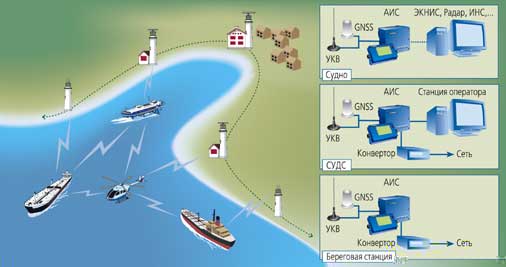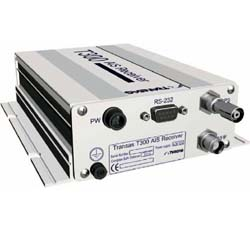
The Automatic Identification System (UAIS or AIS) will be a further step into more safety on board all vessels and for the whole vessel traffic around the world.
The new SOLAS convention Chapter V, Regulation 19, adds a requirement for carriage of automatic identification system capable of providing information about the ship to other ships and to coastal authorities automatically.
AIS is a shipboard broadcast transponder system in which ships continually transmit their ID, position, course, speed over ground, static data and voyage related data to all other ships and shoreside authorities on common VHF radio channels.
The Automatic Identification System is required for certain ship types from July 1st, 2002. The following ships will be required to carry AIS:
- Constructed after the July 1st, 2002 – all new passenger ships and new cargo ships above 300 gt
- Until July 1st, 2003 – all passenger ships and tankers on international voyage
- Until July 1st, 2004 – all cargo ships above 50,000 gt on international voyage
The modification of SOLAS Chapter V contains a new timetable for refitting of AIS:
- Ships, other than passenger ships and tankers, of 300 gt and upwards, but less than 50,000 gt, will be required to fit AIS not later than the first safety equipment survey after July 1st, 2004 or by December 31st 2004, whichever occurs earlier. Ships fitted with AIS shall maintain AIS in operation at all times except where International agreements, rules or standards provide for the protection of navigational information.
AIS is designed to operate in one of the following modes:
- In a ship-to-ship mode for collision avoidance
- As a means for coastal stations to obtain information about a ship and it cargo
- As a traffic management tool when integrated with a Vessel Traffic System (VTS)

Transas UAIS complies with the following international standards:
- IMO MSC.74(69), Annex 3;
- ITU-R M.1371-1;
- ITU-R M.1084-4;
- ITU-R M.823-3;
- IEC 60945;
- IEC 61993-1,2;
- IEC 61162-1,2,3;
- ETS 300 113.
Class C Transas T-55 AIS/GPS Receiver

With the Transas T-55 AIS you can display any AIS equipped vessel within VHF range on any type of AIS adapted display system. The Transas T-55 AIS is compatible with any chart/ECS and radar system capable of accepting standard NMEA 0183 AIS sentences. The installation is quick and simple, requiring only the connection to a VHF antenna, GPS antenna and computer (PC). Transas T-55 AIS is the perfect complement to a radar and has an international standardized interface to Transas Electronic Chart System (ECS) or Navi-Radar 4000 (Chart Radar).
Transas T-55 AIS gives you an accurate position via the built in GPS. It will provide a collision avoidance tool and also make it possible to see behind islands and bends as well as to identify Aids to Navigation devices like buoys and lighthouses. It will be a complement to your navigation during darkness and low visibility.
Transas T-55 AIS provides you with
- An anti collision tool
- Information about merchant ships with AIS
- Navigation warnings from AIS stations
- Accurate position from built in GPS
- Enhanced navigational safety
- AIS presentation
- Dual channel reception
- Metrological data with AIS from weather stations
- NMEA compatibility
- Simple connection and setup
Standard supply:
- AIS receiver T55
- power cable
- operation manual
Options:
- GPS antenna
- VHF antenna
Specification:
| Frequency range: AIS1 AIS2 |
161.975 MHz 162.025 MHz |
| Sensitivity: | -112dBm |
| Antenna impedance: | 50 Ω |
| Power supply: | 9 – 15 VDC |
| Power consumption: | 1.5 W |
| Built-in GPS receiver: | |
| Channels: | 12 |
| Position accuracy: | better than 6 m (2 DRMS) |
| Interfaces: | Antenna BNC VHF Antenna TNC GPS Output/Input 9 pin D-sub |
| Baud rate: | 38400 output |
| Format: | NMEA 0183 |
| Output: | 50 Ω |
| Dimensions: | 196 × 98 × 38 mm |
| Weight: | 0,4 kg |
Shipboard UAIS Transas T103

UAIS Transas T103 has been developed in compliance with IMO Resolution MSC 74 (69), ITU-R Recommendation M.1371-1 and international standards : IEC 61993-2, IEC 60945, IEC 61162.
UAIS Transas T103 is designed for improving safety of navigation in the open sea and coastal waters through the automatic data exchange between vessels and coastal VTS stations of navigational, static and voyage data, information concerning safety of navigation. Also UAIS Transas T103 is used to provide Ship Security Alert system with information of vessel’s position.
UAIS T103 comprises internal GLONASS/GPS receiver.
- “autonomous and continuous” mode for operation in all the regions;
- “assigned” mode for operation in an area subject to a competent authority;
- “a polling” or control mode where the data transfer occurs on response to interrogation of vessels or competent authorities.
Specification:
| Frequencies: | 156.025-162.025 MHz |
| Channel spacing: | 12.5; 25 kHz |
| Data rate:
TDMA DSC
|
9600 bits/s
1200 bits/s
|
| Sensitivity: | -112 dBm |
| Power output: | 12.5 W, 2 W |
| Power supply: | 24 V |
| Internal GNSS receiver: | |
| Channels: | 16 |
| Frequency range: | L1, C/A |
| Update rate: | 1 time/sec |
| VHF Transmitter/Receiver: | |
| Transmitter (TDMA/DSC): | 1 |
| Receivers:
TDMA DSC
|
2
1
|
| Operating temperature: | -15°C to +55°C, 93% humidity |
| Storage temperature: | -20°C to +70°C |
| Vibration: | according to IEC60945 |
| Dimensions:
main unit MKD
|
314 × 260 × 110 mm
220 × 150 × 72 mm
|
| Weight:
main unit MKD
|
5.6 kg
1.0 kg
|
Transas AIS Class B Transponder
The Transas Automatic Identification System (AIS) Class B receiver and transmitter unit is low cost, but high performance product designed specially for the fishing vessels, passenger ships, coastguard, leisure and workboats.
The compact AIS Class B unit is suitable for a variety of applications within the AIS environment. Certified, well-proven technology ensures users of the reliability and quality which has become the hallmark of Transas in today’s fast moving marine industry.
AIS Class B can be connected to any NMEA compatible chart plotter or suitably configured PC or PDA for graphically display of AIS targets.
The Safety Related Message button enables the user to transmit a distress alert to all vessels and base stations within range.
AIS Class B includes an integral GPS module to facilitate ease of installation and use. AIS Class B device can be configured to operate in receive only mode with the transmitter disabled.
Fitting an AIS Class B device ensures you are seen by other AIS equipped vessels. AIS and radar can be fused to create effective and efficient coastal tracking, surveillance and safety systems. As part of a suitably configured network, AIS enables owners to be alerted to unauthorized vessel movements. Also compatible with ECDIS, ECS and RADAR if they support Class B targets.
Designed in compliance with the following standards:
- IEC62287-1 IEC standard, Class B shipborne equipment
- IEC60945 Edn 4.0 IEC standard, environmental requirements
- ITU-RM.1371-1 Universal AIS Technical Characteristics
- IEC61162-1 Edn. 2.0 IEC standard, digital interfaces part 1
- IEC61108-1IEC standard, GPS receiver equipment
Specification:
| Power consumption: | 0.33A continuous |
| Average power consumption: | 4 W |
| Power supply: | 12V DC (9.6-15.6V) |
| GPS Receiver: | IEC 61108-1 compliant |
| Interfaces: | RS232 38.4 kbaud bi-directional RS422 NMEA 38.4 baud bi-directional |
| Connectors: | VHF Antenna connector GPS Antenna connector RS232/RS422/Power |
| VHF Transceiver: | |
| Frequency: | 156.025 to 162.025 MHz in 25KHz steps |
| Output power: | 33dBm ± 1.5 dB |
| Channel bandwidth: | 25 kHz |
| Modulation modes: | 25 kHz GMSK (AIS, TX and RX) 25 kHz AFSK (DSC, RX only) |
| Bit rate: | 9600 b/s ± 50 ppm (GMSK) 1200 b/s ± 30 ppm (FSK) |
| RX sensitivity: | -107dBm 25Khz |
| Message error rate: | 20% |
| Co-channel: | 10dB |
| Adjacent channel: | 70dB |
| Operating temperature: | -25°C to +55°C |
| Vibration: | according to IEC60945 |
| Dimensions: | 190 × 175 × 91 mm |
| Weight: |
1450 g
|
Transas AIS Receiver T300

The Transas Automatic Identification System Receiver T300 is intended to increase safety of navigation for small (NON-SOLAS) vessels and yachts in the open sea and in inshore waters. It does this by automatically receiving navigational, static and voyage data and safety related messages from vessels and shore-based AIS stations, and transmitting them to a display system.
The Transas AIS Receiver T300 meets the requirements of ITU-R M.1371-1, IEC 60945, IEC 61993-2, IEC 61162, ETS 300 113 international standards.
Standard supply:
- 2 VHF TDMA receivers with antenna
- controller
- power supply converter
- enclosure
- software for displaying AIS targets (AISMonitor)
Options:
- GPS receiver with antenna
- electronic chart system
The AIS Receiver T300 performs the following:
Receives automatically from other ships and shore-based VTMS stations information, including:
– IMO number, MMSI, call sign and name of the ship
– ship’s position; course over ground; speed over ground; heading; location of position-fixed GPS antenna; length and beam; ship’s draft
– rate of turn data; type of ship; destination and ETA
– static and additional dynamic data
– short safety related massages
-differential GPS corrections through the VDL AIS channel
Executes channel management commands received via TDMA channel
Indicates AISR status
Broadcasts all VDL received data via port on the ECS display (if one is available).
Specification:
| Frequency range: | 156,025 – 162,025 MHz |
| Channel spacing: | 25 kHz |
| Modulation and data rate:
TDMA
|
9600 bits/s |
| Sensitivity: | -112 dBm |
| VHF Receiver:
TDMA
|
2 |
| Power consumption: | 9-36 W |
| Built-in GPS receiver: | |
| Channels: | 12 |
| Frequency: | L1 |
| Data update rate: | 1 sec |
| Time: | UTC |
| Interfaces: | 1 output port -VDM sentences. GNS, RMC, ZDA (optional)
VHF antenna -Shakespeare 5247 with SO 239 connector or equivalentGPS antenna -GPA017, with TNC connector (optional) |
| Vibration: | according to IEC60945 |
| Dimensions:
With mounting connections and lights With mounting only
|
195 × 141 × 45 mm
160 × 141 × 45 mm
|
| Weight: | 0,6 kg |